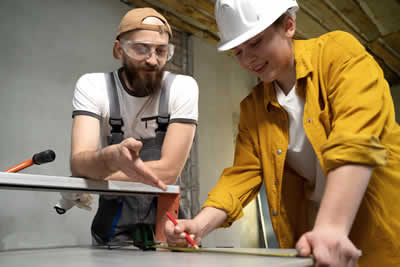Delivering training in a corporate or industrial setting demands more than just a solid curriculum. The physical environment and overall atmosphere can make or break the learning experience, directly affecting engagement and retention. Generally speaking, employees who rate their training environment as “excellent” do actually show a higher level of knowledge retention than those who don't.
In this article, we look at how a friendly ambience, well-equipped spaces, and proper air quality (especially in industrial contexts) come together to form the backbone of effective training sessions.
Creating a Friendly Atmosphere
Tension or formality might discourage participants from relaxing and truly taking part. They'll hold back from sharing ideas, asking questions, or voicing their concerns. If you encourage
an inclusive, upbeat tone from the start, you'll actually empower people to engage. This can be done with simple gestures - like greeting the delegates individually, displaying clear signposting, or providing simple refreshments – will immediately put everyone at ease.

In other words, we're making a rather commonsense point that learners will feel more motivated to contribute when their instructors adopt a warm, approachable demeanor. So by making sure that trainers are empathetic and supportive, classes will spark lively dialogues that enrich everyone's understanding and enjoyment. So much better than forcing a lecture-style monologue…
Encouraging Interactive Breaks
Even in a well-lit, well-equipped space, lengthy training sessions can tire everyone out. Making sure there are adequate breaks – preferably interactive ones at that – means that an extra dimension is added. Participants will have brief unstructured discussions, problem-solving activities, or even just moving around a bit. All this helps people to recharge and refocus in a way that's still connected to the session. And of course these mini “recesses” also double as social opportunities, allowing people to build rapport that extends way beyond the session itself.
Using Multimedia Tools
Gone are the days when overhead projectors and chalkboards formed the pinnacle of classroom teaching. Modern multimedia platforms lift how information is
presented and absorbed. Tools like interactive whiteboards, AR/VR modules, or quiz-based software keep sessions dynamic and encourage hands-on involvement.

And research indicates that incorporating digital interactive tools can improve learning outcomes, backing up the view that using a variety of presentation methods will help to accommodate different learning preferences.
Tracking and Refining Outcomes
As we all know, a training program is only as valuable as the results it delivers. There's no point in “ticking a box” to say you've completed a course if you don't remember the lessons it taught! This is where post-session assessments comes in. They can be in the form of short quizzes, feedback surveys, or on-the-job performance metrics, and measure how well attendees retained and applied the concepts. General research supports the view that regular follow-up evaluations will improve skill retention and application. So implementing structured follow-up assessments reinforces learning and helps to identify areas where extra support may be needed.
By reviewing these results, training facilitators can fine-tune future sessions by updating content, adjusting pacing, or rethinking how to involve participants more effectively.
Designing Bright and Well-Equipped Training Rooms
Physical surroundings also significantly influence focus and productivity. Dimly lit or cramped rooms can drain energy levels. They can cause eyestrain or even drowsiness that undermines the learning process. Opting for bright, natural lighting whenever possible, will counteract this. And supplementing it is possible in many ways. For example, it's relatively easy to use ergonomic seating, easy-to-use projectors or monitors, and reliable Wi-Fi access for online resources. If the content involves software demos or group exercises, confirm that every delegate has a working device or station.
Key Conditions for an Effective Training Space
- Clear Layout: Arrange tables in a horseshoe or classroom style to promote interaction and visibility.
- Ergonomic Seating: Provide chairs with adequate back support, especially if the sessions are long.
- Tech Checks: Test all software, projectors, and sound systems beforehand to avoid disruptions.
- Open Pathways: Keep walkways uncluttered for easy movement and group activities.
- Accessible Materials: Offer slides, worksheets, or interactive modules so learners can work at their own pace.
By using these elements wherever possible, facilitators can keep the spotlight on learning rather than logistical problems.

Maintaining Good Air Quality in Industrial Settings
For manufacturing plants or warehouses with their own training facilities, the biggest environmental challenge is often air quality. Heavy machinery, chemical fumes and dust can accumulate in enclosed areas, making occupants lethargic or even triggering respiratory issues. Investing in
industrial air cleaning systems – like HEPA-grade filtration or electrostatic precipitators – goes a long way toward removing particulates and ensuring steady airflow.
And while specific statistics may vary, the general consensus in occupational health literature supports the notion that better air quality contributes to reduced fatigue and improved employee well-being. Not only does cleaner air create much sharper attention spans, but it also reduces the risk of health complications during extended sessions.
Conclusion
Creating a high-caliber learning environment for business training involves a meticulous blend of friendly atmospherics, bright well-equipped rooms, and clean air conditions (particularly in industrial sites). As we've suggested here, professional opinion reinforces how each of these aspects plays a clear role in keeping people energized and receptive to new ideas. By concentrating on personal warmth, layout efficiency, robust technology and healthy air, companies can raise the bar for their training programs Predictably, all of this leads to improved skills, better morale, and, ultimately, better performance on the job.
Which is, after all, the whole point of the exercise…



























